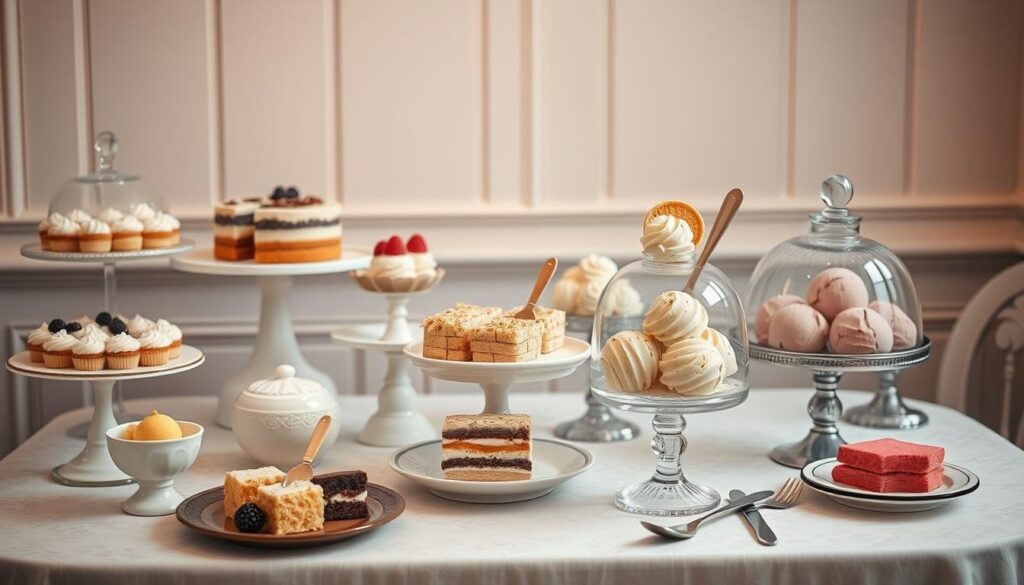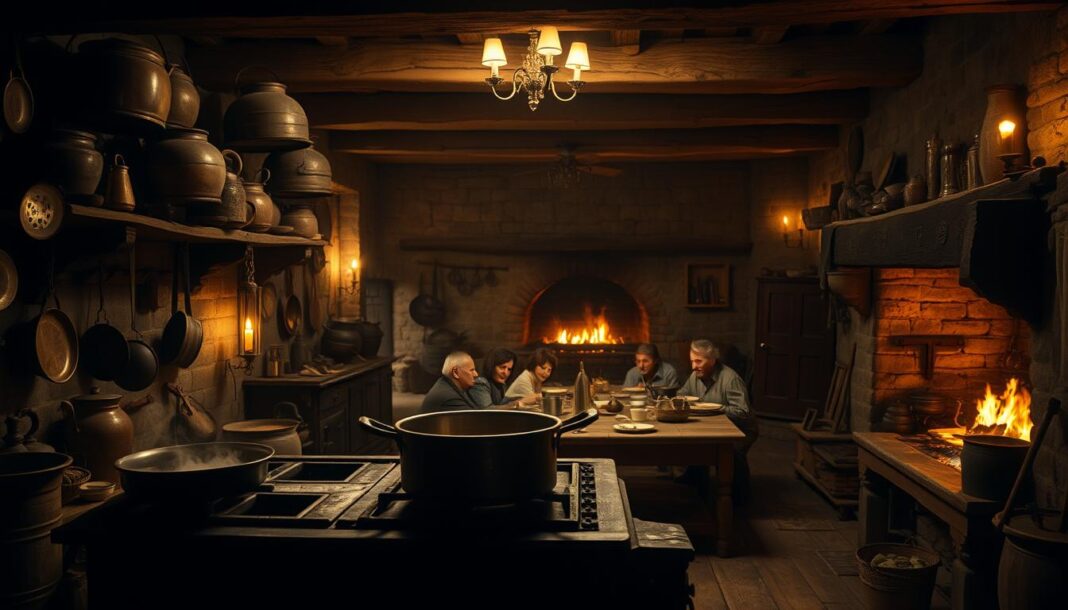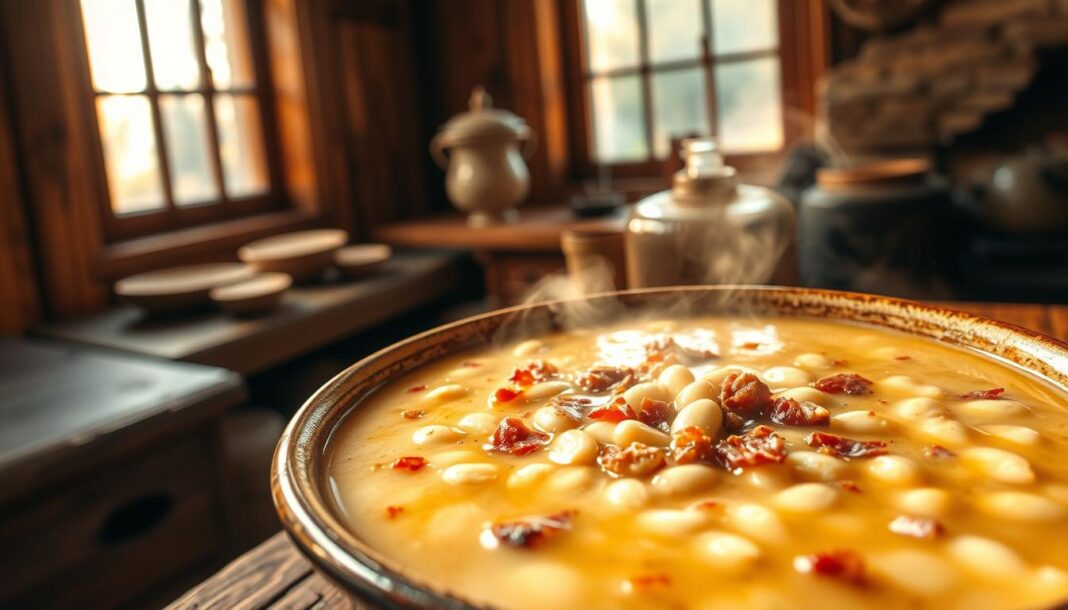Embarking on a culinary journey through time, we explore the rich tapestry of food and cooking that has shaped human history. From ancient civilizations to the 20th century, we’ll uncover the authentic historic recipes that have influenced our culinary heritage.
As we delve into the evolution of cooking techniques, ingredients, and food preferences, we’ll examine how different cultures have contributed to the diverse culinary landscape we enjoy today. By understanding how our ancestors cooked and celebrated through food, we can recreate these historic recipes in our modern kitchens, gaining valuable insights into the past.
The Fascinating World of Culinary History
As we delve into the fascinating world of culinary history, we uncover the intricate relationships between food, culture, and society. This field of study offers more than just a collection of old recipes; it provides a window into the past, revealing how our ancestors lived, cooked, and interacted with one another.
Why Historic Recipes Matter
- Historic recipes serve as edible time capsules, offering a tangible way to connect with the past.
- By recreating these dishes, we gain insights into the daily lives and resource availability of people who lived years ago.
How Food Reflects Culture and Society
Food has always been more than mere sustenance; it reflects social hierarchies, religious beliefs, and cultural exchanges. Over the years, recipes have evolved as ingredients traveled along trade routes and cooking techniques advanced, shaping the culinary landscape in profound ways.

Ancient Culinary Traditions
As we journey through the culinary history of ancient civilizations, we uncover the sophisticated flavors and techniques that defined their gastronomic traditions. Ancient cultures left behind a rich culinary heritage, with recipes and cooking methods that continue to inspire modern chefs and home cooks alike.
Mesopotamian Delicacies
Mesopotamian cuisine was known for its innovative combinations of ingredients, such as date and pistachio pastries. These sweet treats showcased the region’s abundant fruit cultivation and extensive trade connections. To recreate these ancient delights, we can use a pastry wrapping filled with dates and pistachios, highlighting the natural sweetness and rich flavors of the ingredients.
Date and Pistachio Pastries
One of the hallmarks of Mesopotamian baking was the use of locally sourced ingredients to create intricate pastry designs. By combining dates and pistachios, these ancient bakers created a delightful contrast of textures and flavors.
Ancient Roman Cuisine
Roman culinary traditions were documented in cookbooks like Apicius, providing insights into their cooking techniques and flavor preferences. Roman cuisine featured dishes such as spiral-shaped fried fritters drizzled with honey, demonstrating their fondness for simple yet satisfying sweet treats.
Spiral-Shaped Fried Pastries with Honey
These fried pastries, made with a simple batter, were a staple in Roman cuisine. Topped with honey and poppy seeds, they represent a culinary delight that has stood the test of time.
Fresh Cheese Making Techniques
The Romans were also skilled in cheese making, producing a range of varieties from soft, fresh cheese to aged, hard types. Their techniques involved traditional curdling methods, resulting in a product that’s both versatile and flavorful.

Medieval Gastronomy
The medieval period was marked by a fascinating blend of culinary practices, with dishes that reflected the cultural exchange of the time. As trade routes expanded and cultural interactions increased, medieval cuisine became a rich tapestry of flavors and techniques.
North African and Middle Eastern Influences
Medieval cuisine was significantly influenced by North African and Middle Eastern culinary traditions. This is evident in dishes such as the 10th century Baghdad lamb stew, a complex and slightly sour concoction that was reportedly consumed as a hangover cure. The use of exotic spices and herbs in this stew exemplifies the sophisticated cooking of the Islamic Golden Age.
10th Century Baghdad Lamb Stew
This stew represented a pinnacle of medieval culinary sophistication, featuring a delicate balance of herbs and a hint of sourness. Its preparation and consumption as a hangover remedy highlight the resourcefulness and culinary expertise of medieval cooks.
Medieval French Cooking
Medieval French cuisine showcased regional ingredients through innovative dishes like fried fig and apple pastries. These pastries combined local fruits with exotic spices obtained through trade routes, demonstrating medieval cooks’ understanding of complementary flavors. Another hearty dish was the wheat berry porridge thickened with egg yolks, a nutritious fare that sustained medieval populations during colder months.
Fried Fig and Apple Pastries
These pastries were filled with a delicious mixture of figs, apples, raisins, nuts, and spices, showcasing the medieval ability to blend local and exotic ingredients. The combination of flavors and textures in these pastries was a hallmark of medieval culinary creativity.
Wheat Berry Porridge with Egg Yolks
The wheat berry porridge, enriched with egg yolks, was a staple that provided sustenance and warmth. This dish exemplifies the medieval emphasis on hearty, nutritious food that could sustain people through the rigors of daily life.
Italian Medieval Dishes
Italian medieval cuisine laid the groundwork for many dishes still enjoyed today, including an early version of gnocchi made primarily with cheese. This pre-potato gnocchi highlights the resourcefulness of medieval Italian cooks who utilized available ingredients to create satisfying and filling dishes.
Pre-Potato Cheese Gnocchi
The use of cheese as a primary ingredient in these gnocchi demonstrates the medieval Italian ability to craft delicious dishes from locally available resources. This early version of gnocchi showcases the evolution of Italian cuisine over time.
18th Century Historic Recipes

As we explore 18th-century historic recipes, we uncover a world of culinary sophistication and creativity. The 18th century marked a period of culinary refinement and innovation in Europe and colonial America, with cookbooks becoming more widely available to the growing middle class.
British Isles Culinary Traditions
British culinary traditions of this era featured sophisticated meat preparations, such as larded venison with wine sauce, showcasing the importance of game in aristocratic dining. The wine sauce accompanying the venison demonstrates the 18th century’s growing appreciation for complementary flavors and sauces that enhanced the main dish.
Larded Venison with Wine Sauce
This dish was a staple of aristocratic dining, with the larding process adding both flavor and tenderness to the venison. The rich wine sauce, made with high-quality ingredients, further elevated the dish.
Pineapple Tarts
Pineapple tarts represent the fascination with exotic ingredients that were becoming available through expanded colonial trade networks. Despite containing just three ingredients—pineapple, sugar, and wine—these tarts delivered complex flavors that belied their simple composition.
Early American Cooking
Early American cooking began to develop its distinct identity during this period, adapting European techniques to local ingredients and conditions. Sugar, once a luxury item, became more accessible during this century, transforming dessert-making and contributing to the popularity of sweet pies and tarts.
The Surprising History of 18th Century Ice Cream
Contrary to popular belief, ice cream was already a fashionable dessert in the 18th century, enjoyed by elites who could afford the labor-intensive process of making frozen treats without modern refrigeration. The history of ice cream in this era is a testament to the creativity and resourcefulness of cooks who managed to create this beloved dessert under challenging conditions.
19th Century Cooking Innovations
The 19th century was a transformative period for global cuisine, marked by significant innovations in cooking techniques and ingredients. This era saw the rise of new cooking technologies and the increased availability of various foods, leading to the development of novel dishes and culinary traditions.
Russian Culinary Developments
Russian cuisine gained international recognition during this period, with dishes like beef Stroganoff becoming culinary ambassadors. The traditional preparation of beef Stroganoff featured allspice as a key flavoring component.
Traditional Beef Stroganoff with Allspice
This dish, named after the influential Stroganov family, showcased Russian culinary expertise and its ability to blend flavors.
Eastern European Specialties
Eastern European cooking traditions became better documented in the 19th century. One of the region’s most famous dishes to emerge was Hungarian goulash, originally prepared as a soup rather than the thick stew many associate with it today.
Hungarian Goulash Soup
Authentic Hungarian goulash was a clear soup, highlighting the evolution of recipes as they crossed cultural boundaries.
American 19th Century Sweets
American confectionery in the 19th century included labor-intensive creations like glacé cherries, which involved coating fruit in multiple layers of hardened sugar. The 19th century saw sugar becoming increasingly affordable, leading to more elaborate sweet preparations. The use of sugar in these recipes was characteristic of the era’s desserts.
| Dish | Origin | Key Ingredient |
|---|---|---|
| Beef Stroganoff | Russian | Beef |
| Hungarian Goulash | Eastern European | Soup |
| Glacé Cherries | American | Sugar |
Wartime Recipes and Adaptations
During times of war, culinary creativity often flourishes as people adapt traditional recipes to the harsh realities of ingredient shortages and rationing. This adaptability is evident in the innovative dishes created during World War II and the Great Depression era.
World War II Culinary Creativity
The scarcity of ingredients during World War II led to the development of unique recipes. For instance, Italian cooks created a chestnut flour cake using naturally sweet chestnut flour, lemon, and yeast. This cake was notably drier and denser than its peacetime counterparts, reflecting the compromises made during wartime scarcity.
Italian Chestnut Flour Cake
The use of chestnut flour in this cake not only addressed sugar shortages but also resulted in a distinct flavor profile. The combination of lemon and yeast helped to enhance the cake’s taste, making it a notable example of wartime culinary innovation.
Dutch Tulip Bulb Stew
In the Netherlands, during the “Hunger Winter” of 1944-45, desperate circumstances led to the consumption of tulip bulbs, which were incorporated into traditional potato-based stews. This stew became a vital source of nutrition, highlighting the extreme measures taken during food shortages.
Great Depression Era Cooking
Cooking during the Great Depression emphasized stretching ingredients and reducing waste. In America, cooks developed inventive recipes, such as the chocolate gelatin Christmas pudding, which maintained holiday traditions despite the economic hardship.
Chocolate Gelatin Christmas Pudding
This pudding exemplifies how holiday traditions were maintained by adapting recipes to use more affordable and available ingredients. The use of gelatin and chocolate created a unique dessert that became a staple during difficult times.
20th Century American Historic Recipes

American cuisine in the 20th century evolved significantly, influenced by historical events, cultural exchange, and technological advancements. This period saw the development of distinctive national dishes and regional specialties that now form part of our culinary heritage.
Nostalgic School Lunch Favorites
School lunch programs in the United States created unique recipes optimized for mass production. One such iconic dish is the rectangular pizza with its distinctive pourable crust, a nostalgic favorite among many Americans.
1980s-Style School Pizza
This 1980s-style school pizza recipe recreates the nostalgic flavor and texture that generations of American schoolchildren experienced. If you had cheese pizza at school in the 80s or 90s, this recipe will be a walk down memory lane.
Classic American Cookies
Classic American cookies became standardized during the 20th century. Crispy sugar cookies, in particular, represent a simple yet beloved treat that has remained popular across decades.
Crispy Sugar Cookies
These sugar cookies—described as “crispy, delicious, and extremely snackable”—demonstrate how basic ingredients like sugar can create enduring favorites when properly balanced.
Traditional Holiday Treats
Traditional holiday recipes like homemade eggnog continued to be made in American homes even as commercial versions became widely available. Rich, boozy eggnog flavored with nutmeg represents the continuation of colonial-era traditions into modern American holiday celebrations.
Rich Homemade Eggnog
The cream used in traditional eggnog exemplifies how dairy products remained central to American desserts and holiday treats throughout the 20th century in the United States. This rich, homemade eggnog recipe is easy to make and far superior to store-bought versions.
International 20th Century Dishes
The 20th century witnessed a significant exchange of culinary practices globally, leading to the popularization of international dishes. This era saw the blending of traditional cooking methods with modern techniques and ingredients, resulting in the creation of new recipes.
Filipino Culinary Traditions
Filipino cuisine represents a fascinating fusion of indigenous, Spanish, Chinese, and American influences. A notable dish that exemplifies this blend is the complex recipe of rice and egg noodles with shrimp and pork belly, showcasing the importance of rice as a staple ingredient.
Rice and Egg Noodles with Shrimp and Pork
This dish skillfully combines multiple textures and flavors, featuring pork as a primary protein source alongside seafood. The combination reflects the archipelago’s rich agricultural and fishing traditions.
Italian 20th Century Classics
Italian cuisine became increasingly standardized and internationally recognized during the 20th century. Pasta dishes evolved significantly as ingredients became more widely available and cooking techniques were refined for modern kitchens, leading to the creation of new recipe variations.
As international recipe exchanges accelerated, Italian classics gained global appreciation, and their influence can be seen in modern fusion cuisine.
Bread-Making Through the Ages
From ancient flatbreads to modern artisanal loaves, the journey of bread-making reflects the culinary advancements of human societies. Bread has been a dietary staple across civilizations for thousands of years, with techniques evolving significantly over time.
Ancient Techniques and Medieval Varieties
Ancient bread techniques relied on wild yeasts and bacteria captured in sourdough starters. Baking was often done in clay ovens or on heated stones, using various types of flour from ancient grains like emmer and einkorn. Medieval bread varieties were differentiated by social class, with refined white bread for the wealthy and coarser breads for the common people.
Colonial and Early American Breads
Colonial and early American breads reflected European heritage and adaptation to new ingredients, including cornmeal and regional grain varieties. The introduction of commercial yeast in the 19th century revolutionized bread-making, making it more predictable.
The Sourdough Revival
The recent sourdough revival represents a return to ancient techniques using natural fermentation. Historical baking methods utilized wood-fired ovens, creating distinctive crusts and flavors.
| Period | Bread Type | Baking Method |
|---|---|---|
| Ancient | Flatbreads, Sourdough | Clay ovens, Heated stones |
| Medieval | White bread, Coarse bread | Wood-fired ovens |
| Colonial American | Cornbread, Regional grain breads | Wood-fired ovens, Brick ovens |
For more historical recipes, visit our collection at https://historicalfoods.com/historical-recipes/.
Historic Desserts and Sweet Treats

The story of desserts through history is a tale of innovation, cultural exchange, and the universal human love for sweetness. Sweet treats have been part of human culinary traditions since ancient times, though the ingredients and preparation methods have evolved dramatically.
Ancient Sweet Delicacies
Ancient civilizations relied on natural sweeteners like honey and dried fruits to create their desserts. These ancient sweet delicacies were often simple yet flavorful, showcasing the ingenuity of ancient cooks.
Medieval Puddings and Custards
During the medieval period, puddings and custards became popular, often combining eggs, bread, and available sweeteners. These medieval puddings ranged from simple porridges to elaborate spiced creations served at noble tables, highlighting the use of sugar as a status symbol.
18th and 19th Century Cakes
The development of more reliable ovens and the increasing availability of sugar transformed cake-making in the 18th and 19th centuries. This allowed for more consistent and elaborate cakes, making them a staple of celebrations and special occasions.
Traditional Ice Creams and Frozen Desserts
Ice cream has a surprisingly long history, with frozen desserts appearing in elite dining as early as the 18th century. The process of making ice cream was labor-intensive, requiring ice to be harvested and stored in ice houses, making it an exclusive luxury before mechanical refrigeration.
The evolution of desserts through history reflects changing technology, ingredient availability, and cultural values around sweetness and indulgence. As we explore these historic desserts and treats, we gain insight into the past, understanding how our ancestors lived, celebrated, and enjoyed their sweet indulgences, including pudding and other sweet treats made with sugar.
Soups and Stews From History
As we explore the history of soups and stews, we uncover the evolution of cooking techniques and the cultural significance of these dishes. Soups and stews represent some of humanity’s oldest cooking methods, transforming from simple boiled ingredients to complex, layered dishes with distinct cultural identities.
Ancient Soup Preparations
Ancient soup preparations often served as efficient ways to extract maximum nutrition from limited ingredients. Variations were found across virtually all early civilizations, showcasing the versatility of this cooking method.
Medieval Pottages
Medieval pottages—thick, often grain-based soups—formed the daily sustenance for most European people. Ingredients varied by season and availability, reflecting the resourcefulness of medieval cooking.
Colonial Era Stews
Colonial era stews incorporated native vegetables like potatoes, transforming European cooking. These stews reflected both European traditions and adaptation to New World ingredients.
19th Century Soup Innovations
The 19th century brought innovations in soup-making, including Hungarian goulash, originally prepared as a soup. The development of commercial food preservation, like canning, made soups available year-round, changing how they were prepared and consumed.
Historic Meat Preparation Techniques
Historically, meat preparation techniques have been shaped by the resources available, the need for preservation, and the cultural context of the time. The evolution of these techniques reflects changes in technology, societal needs, and culinary traditions.
Ancient Meat Preservation
Ancient civilizations developed various methods to preserve meat, including smoking, salting, drying, and fermentation. These techniques not only extended the shelf life of meat but also created distinctive flavors that remain popular today. For instance, salting was commonly used to preserve beef and pork, while smoking added a rich flavor to various meats.
Medieval Roasting Methods
During the medieval period, roasting meat over open fires was a common practice. Meat was often cooked on spits, requiring regular basting to prevent drying out. This method was used for various meats, including pork and game.
18th Century Game Preparation
The 18th century saw refined game preparation techniques, such as larding—inserting strips of fat into leaner meats like venison to enhance moisture and flavor during cooking. A larded roast venison tenderloin served with a delicious wine sauce was a notable dish. This period also demonstrated a growing sophistication in creating complementary sauces for roasted meats.
Traditional Beef Dishes Through Time
Beef dishes have evolved significantly over time, from simple roasts cooked in an oven to complex preparations like 19th-century beef Stroganoff, seasoned with allspice. For those interested in exploring more historical roast recipes, our guide on Christmas roast goose offers expert roasting techniques and recipes.
Historic poultry preparation included exotic birds, with recipes sometimes suggesting substitutions like duck for flamingo, which modern cooks can use to approximate historical flavors. Serving these dishes with a sweet and savory sauce enhanced their flavor profiles.
Forgotten Ingredients in Historic Recipes
Culinary traditions of the past were built on a wide range of ingredients, some of which have largely disappeared from modern kitchens. As we explore these forgotten ingredients, we gain a deeper understanding of the resourcefulness and creativity of our culinary ancestors.
Ancient Grains and Their Uses
Ancient grains like emmer, einkorn, and spelt were staples before modern wheat varieties dominated. These grains offered distinctive flavors and nutritional profiles that influenced historical breads and porridges made with various types of flour. Specialized flours, such as chestnut flour used in wartime Italian baking, provided alternatives when wheat flour was scarce or expensive.
Medieval Spices and Herbs
Medieval cooking utilized a broader range of spices than typically found in modern Western kitchens. Combinations that might seem unusual to contemporary palates included ginger alongside spices like long pepper, grains of paradise, and galangal. These spices added unique flavors to dishes.
Unusual Ingredients from Colonial Cooking
Colonial cooking incorporated ingredients like corn that were adopted from indigenous American cuisines, transforming European culinary traditions. Raisins appeared frequently in both sweet and savory historic dishes, often combined with meat in ways that might surprise modern diners. Raisins and ginger were also used together in various recipes.
Substitutions for Modern Cooks
For modern cooks attempting historic recipes, practical substitutions for hard-to-find ingredients can help maintain the spirit of the original dishes. Using alternative types of flour can help achieve authentic flavors. Understanding these substitutions is key to successfully recreating historical recipes.
| Historic Ingredient | Modern Substitute | Usage |
|---|---|---|
| Emmer | Spelt or Kamut | Breads, porridges |
| Long pepper | Black pepper or ginger | Savory dishes |
| Corn | Maize or cornmeal | Baked goods, savory dishes |
Recreating Historic Recipes in Modern Kitchens
As we attempt to recreate historic recipes, we must navigate the challenges of translating ancient cooking methods to modern kitchen environments. This process involves understanding historical cooking techniques and adapting them to contemporary cooking tools.
Adapting Cooking Methods
One of the primary challenges is adapting cooking methods from historic recipes to modern kitchens. Many traditional recipes were designed for hearth cooking or wood-fired ovens, which required different techniques than modern electric or gas ovens. We must translate these instructions to work with precise temperature controls, often resulting in a more consistent final product.
Finding Authentic Ingredients
Another challenge is sourcing authentic ingredients for historic recipes. This may involve finding specialty suppliers, visiting farmers’ markets, or even growing our own herbs and vegetables to match historical varieties. By using authentic ingredients, we can ensure that our recreations are as true to the original as possible.
Measuring and Timing Challenges
Historic recipes often lack specific measurements and times, instead using descriptive instructions like “cook until done” or “baking in a moderate oven.” To overcome this, we must test and experiment to determine the appropriate quantities and time required for each recipe.
Essential Tools for Historical Cooking
While some enthusiasts collect antique or reproduction cooking tools, most historic cooking techniques can be adapted for standard modern kitchen equipment. Understanding the principles behind historical cooking techniques is often more important than having period-specific tools, allowing for successful adaptations with contemporary equipment.
The Cultural Context of Historic Recipes
Understanding historic recipes requires more than just following old cooking instructions; it demands a deep dive into the cultural context that shaped them. The way people prepared and consumed food was influenced by a complex array of factors, including social status, religious practices, and economic conditions.
Social Status and Food
Food has long been a marker of social status, with certain ingredients and dishes reserved for the wealthy. For instance, white sugar and fine spices were once luxuries only the affluent could afford, making their presence in a recipe a clear indicator of the dish’s intended social class. We see this in the elaborate presentation and exotic ingredients used in noble tables, contrasting with the practical preservation methods used by common people.
Religious Influences
Religious practices have also profoundly shaped historical cooking. Fasting requirements and feast days created distinct culinary traditions across different faith communities. Many beloved holiday treats originated as special foods prepared only for religious celebrations, when ingredients normally considered luxuries might be used. This is a testament to how deeply intertwined food and faith have been throughout history.
Seasonal Eating and Feast Days
Seasonal eating was not a lifestyle choice but a necessity throughout most of history. Preservation techniques were developed to extend the availability of foods beyond their natural growing season. Feast days and special occasions generated some of the most elaborate and well-documented historic recipes, as these were times when communities invested extraordinary effort in food preparation. The treat that we enjoy today during holidays has its roots in these historical practices.
By examining these factors, we gain a richer understanding of the cultural context that shaped historic recipes, and we can appreciate the complexity and significance of the food we eat today.
Conclusion: Preserving Culinary Heritage Through Historic Recipes
Our exploration of historic recipes reveals a fascinating narrative of cultural exchange and culinary evolution. By examining historic recipes from various centuries, we gain insights into the lives of our ancestors and the ways they utilized available ingredients to create nourishing and flavorful dishes.
The evolution of poultry dishes, particularly chicken recipes, demonstrates how cooking techniques have adapted over time while retaining certain traditional methods. This continuity is a testament to the enduring power of culinary heritage.
Preserving these recipes from the past allows us to reconnect with our cultural roots and appreciate the sophistication and complexity of historical cooking. As we move forward into the future, understanding our culinary past provides valuable context for contemporary food trends and inspires more informed choices in our own cooking practices.


